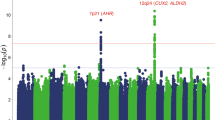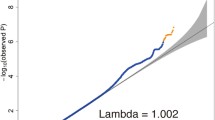Abstract
Estimated heritability of coffee intake ranges from 0.36 to 0.58, however, these point estimates assume that inherited effects are the same throughout the distribution of coffee intake, i.e., whether consumption is high or low relative to intake in the population. Quantile regression of 4788 child–parent pairs and 2380 siblings showed that offspring–parent and sibling concordance became progressively greater with increasing quantiles of coffee intake. Each cup/day increase in the parents’ coffee intake was associated with an offspring increase of 0.020 ± 0.013 cup/day at the 10th percentile of the offsprings’ coffee intake (slope ± SE, NS), 0.137 ± 0.034 cup/day at their 25th percentile (P = 5.2 × 10–5), 0.159 ± 0.029 cup/day at the 50th percentile (P = 5.8 × 10–8), 0.233 ± 0.049 cup/day at the 75th percentile (P = 1.8 × 10–6), and 0.284 ± 0.054 cup/day at the 90th percentile (P = 1.2 × 10–7). This quantile-specific heritability suggests that factors that distinguish heavier vs. lighter drinkers (smoking, male sex) will likely manifest differences in estimated heritability, as reported.


Similar content being viewed by others
References
Backman JT, Schroder MT, Neuvonen PJ (2008) Effects of gender and moderate smoking on the pharmacokinetics and effects of the CYP1A2 substrate tizanidine. Eur J Clin Pharmacol 64:17–24
Coffee and Caffeine Genetics Consortium, Cornelis MC, Byrne EM, Esko T, NallsMA, Ganna A, Paynter N, Monda KL, Amin N, Fischer K, Renstrom F, Ngwa JS, Huikari V, Cavadino A, Nolte IM, Teumer A, Yu K, Marques-Vidal P, Rawal R, Manichaikul A, Wojczynski MK, Vink JM, Zhao JH, Burlutsky G, Lahti J, Mikkilä V, Lemaitre RN, Eriksson J, Musani SK, Tanaka T, Geller F, Luan J, Hui J, Mägi R, Dimitriou M, Garcia ME, Ho WK, Wright MJ, Rose LM, Magnusson PK, Pedersen NL, Couper D, Oostra BA, Hofman A, Ikram MA, Tiemeier HW, Uitterlinden AG, van Rooij FJ, Barroso I, Johansson I, Xue L, Kaakinen M, Milani L, Power C, Snieder H, Stolk RP, Baumeister SE, Biffar R, Gu F, Bastardot F, Kutalik Z, Jacobs DR Jr, Forouhi NG, Mihailov E, Lind L, Lindgren C, Michaëlsson K, Morris A, Jensen M, Khaw KT, Luben RN, Wang JJ, Männistö S, Perälä MM, Kähönen M, Lehtimäki T, Viikari J, Mozaffarian D, Mukamal K, Psaty BM, Döring A, Heath AC, Montgomery GW, Dahmen N, Carithers T, Tucker KL, Ferrucci L, Boyd HA, Melbye M, Treur JL, Mellström D, Hottenga JJ, Prokopenko I, Tönjes A, Deloukas P, Kanoni S, Lorentzon M, Houston DK, Liu Y, Danesh J, Rasheed A, Mason MA, Zonderman AB, Franke L, Kristal BS; International Parkinson's Disease Genomics Consortium (IPDGC), North American Brain Expression Consortium (NABEC), UK Brain Expression Consortium (UKBEC), Karjalainen J, Reed DR, Westra HJ, Evans MK, Saleheen D, Harris TB, Dedoussis G, Curhan G, Stumvoll M, Beilby J, Pasquale LR, Feenstra B, Bandinelli S, Ordovas JM, Chan AT, Peters U, Ohlsson C, Gieger C, Martin NG, Waldenberger M, Siscovick DS, Raitakari O, Eriksson JG, Mitchell P, Hunter DJ, Kraft P, Rimm EB, Boomsma DI, Borecki IB, Loos RJ, Wareham NJ, Vollenweider P, Caporaso N, Grabe HJ, Neuhouser ML, Wolffenbuttel BH, Hu FB, Hyppönen E, Järvelin MR, Cupples LA, Franks PW, Ridker PM, van Duijn CM, Heiss G, Metspalu A, North KE, Ingelsson E, Nettleton JA, van Dam RM, Chasman DI (2015) Genome-wide meta-analysis identifies six novel loci associated with habitual coffee consumption. Mol Psychiatry. 20:647–656
Conterio F, Chiarelli B (1962) Study of the inheritance of some daily life habits. Heredity 17:347–359
Cornelis MC (2014) Gene-coffee interactions and health. Curr Nutr Rep 3:178–195
Cornelis MC (2015) Toward systems epidemiology of coffee and health. Curr Opin Lipidol. 26:20–29
Falconer DS, Mackay TFC (1996) Introduction to quantitative genetics, 4th edn. Longmans Green, Harlow, Essex, UK
Farag NH, Whitsett TL, McKey BS, Wilson MF, Vincent AS, Everson-Rose SA, Lovallo WR (2010) Caffeine and blood pressure response: sex, age, and hormonal status. J Womens Health (Larchmt) 19:1171–1176
Fredholm BB, Battig K, Holmen J, Nehlig A, Zvartau EE (1999) Actions of caffeine in the brain with special reference to factors that contribute to its widespread use. Pharmacol Rev 51:83–133
Freedman ND, Park Y, Abnet CC, Hollenbeck AR, Sinha R (2012) Association of coffee drinking with total and cause-specific mortality. N Engl J Med. 366:1891–1904
Gould WW (1992) Quantile regression with bootstrapped standard errors. Stata Tech Bull 9:19–21
Gunes A, Dahl ML (2008) Variation in CYP1A2 activity and its clinical implications: influence of environmental factors and genetic polymorphisms. Pharmacogenomics 9:625–637
Hallström H, Melhus H, Glynn A, Lind L, Syvanen AC, Michaelsson K (2010) Coffee consumption and CYP1A2 genotype in relation to bone mineral density of the proximal femur in elderly men and women: a cohort study. Nutr Metab (Lond) 7:12
Harland BF (2000) Caffeine and nutrition. Nutrition 16:522–526
Heckman MA, Weil J, Gonzalez de Mejia E (2010) Caffeine (1, 3, 7-trime-thylxanthine) in foods: a comprehensive review on consumption, functionality, safety, and regulatory matters. J Food Sci 75:R77–R87
Hettema JM, Corey LA, Kendler KS (1999) A multivariate genetic analysis of the use of tobacco, alcohol, and caffeine in a population based sample of male and female twins. Drug Alcohol Depend 57:69–78
Juliano LM, Griffiths RR (2004) A critical review of caffeine withdrawal: empirical validation of symptoms and signs, incidence, severity, and associated features. Psychopharmacology 176:1–29
Kannel WB, Feinleib M, McNamara PM, Garrison RJ, Castelli WP (1979) An investigation of coronary heart disease in families. The Framingham offspring study. Am J Epidemiol 110:281–290
Karlin S, Cameron EC, Williams PT (1981) Sibling and parent-offspring correlation estimation with variable family size. Proc Natl Acad Sci USA 78:2664–2668
Kendler KS, Prescott CA (1999) Caffeine intake, tolerance, and withdrawal in women: a population-based twin study. Am J Psychiatry 156:223–228
Koenker R, Hallock KF (2001) Quantile regression. J Econ Perspect 15:143–156
Laitala VS, Kaprio J (2008) Silventoinen K (2008) Genetics of coffee consumption and its stability. Addiction 103:2054–2061
Loftfield E, Freedman ND, Dodd KW, Vogtmann E, Xiao Q, Sinha R, Graubard BI (2016) Coffee drinking is widespread in the United States, but usual intake varies by key demographic and lifestyle factors. J Nutr 146:1762–1768
Luciano M, Kirk KM, Heath AC, Martin NG (2005) The genetics of tea and coffee drinking and preference for source of caffeine in a large community sample of Australian twins. Addiction 100:1510–1517
Reynolds CA, Barlow T, Pedersen NL (2006) Alcohol, tobacco and caffeine use: spouse similarity processes. Behav Genet 36:201–215
Rodenburg EM, Eijgelsheim M, Geleijnse JM, Amin N, van Duijn CM, Hofman A, Uitterlinden AG, Stricker BH, Visser LE (2012) CYP1A2 and coffee intake and the modifying effect of sex, age, and smoking. Am J Clin Nutr 96:182–187
Sachse C, Brockmoller J, Bauer S, Roots I (1999) Functional significance of a C/A polymorphism in intron 1 of the cytochrome P450 CYP1A2 gene tested with caffeine. Br J Clin Pharmacol 47:445–449
Smith A (2002) Effects of caffeine on human behavior. Food Chem Toxicol 40:1243–1255
Soroko S, Chang J, Barrett-Connor E (1996) Reasons for changing caffeinated coffee consumption: the Rancho Bernardo Study. J Am Coll Nutr 15:97–101
Swan GE, Carmelli D, Cardon LR (1996) The consumption of tobacco, alcohol, and coffee in Caucasian male twins: a multivariate genetic analysis. J Subst Abuse 8:19–31
Teucher B, Skinner J, Skidmore PM, Cassidy A, Fairweather-Tait SJ, Hooper L, Roe MA, Foxall R, Oyston SL, Cherkas LF, Perks UC, Spector TD, MacGregor AJ (2007) Dietary patterns and heritability of food choice in a UK female twin cohort. Twin Res Hum Genet 10:734–748
Treur JL, Taylor AE, Ware JJ, Nivard MG, Neale MC, McMahon G, Hottenga JJ, Baselmans BM, Boomsma DI, Munafò MR, Vink JM (2017) Smoking and caffeine consumption: a genetic analysis of their association. Addict Biol 22:1090–1102
Williams PT (2012) Quantile-specific penetrance of genes affecting lipoproteins, adiposity and height. PLoS ONE 7(1):e28764
Acknowledgements
The data were obtained from the National Institutes of Health FRAMCOHORT, GEN3, FRAMOFFSPRING Research Materials obtained from the NHLBI Biologic Specimen and Data Repository Information Coordinating Center. The author (PTW) was responsible for the project conception, development of overall research plan, analyzing data including performing the statistical analysis, and wrote the paper. The sole author had responsibility for all parts of the manuscript. There are no conflicts of interest to report. The Framingham Heart Study was conducted and supported by the National Heart, Lung, and Blood Institute (NHLBI) in collaboration with Boston University (Contract No. N01-HC-25195 and HHSN268201500001I). This manuscript was not prepared in collaboration with investigators of the Framingham Heart Study and does not necessarily reflect the opinions or views of the Framingham Heart Study, FRAMCOHORT, GEN3, FRAMOFFSPRING, Boston University, or NHLBI.
Funding
This research was supported by Grant R21ES020700 from the National Institute of Environmental Health Sciences, and an unrestricted gift from HOKA ONE ONE.
Author information
Authors and Affiliations
Corresponding author
Ethics declarations
Conflict of interest
Paul T. Williams declares that he has no conflict of interest.
Human and Animal Rights and Informed Consent
These analyses were approved by Lawrence Berkeley National Laboratory Human Subjects Committee (HSC) for protocol “Gene-environment interaction vs quantile-dependent penetrance of established SNPs (107H021)” LBNL holds Office of Human Research Protections Federal wide Assurance number FWA 00006253. Approval number: 107H021-13MR20.
Additional information
Edited by Gitta Lubke.
Publisher's Note
Springer Nature remains neutral with regard to jurisdictional claims in published maps and institutional affiliations.
Rights and permissions
About this article
Cite this article
Williams, P.T. Quantile-Specific Heritability may Account for Gene–Environment Interactions Involving Coffee Consumption. Behav Genet 50, 119–126 (2020). https://doi.org/10.1007/s10519-019-09989-0
Received:
Accepted:
Published:
Issue Date:
DOI: https://doi.org/10.1007/s10519-019-09989-0




